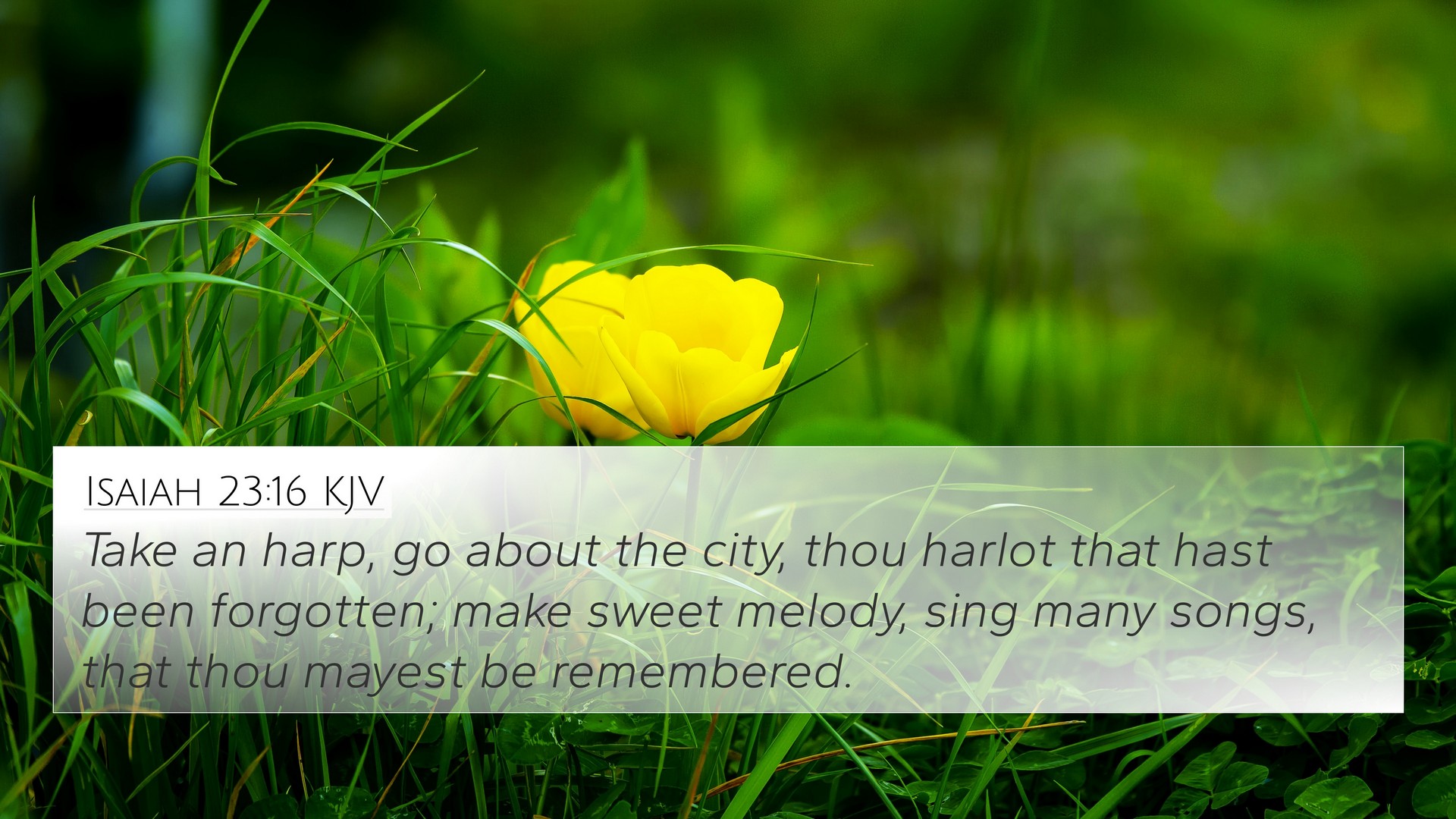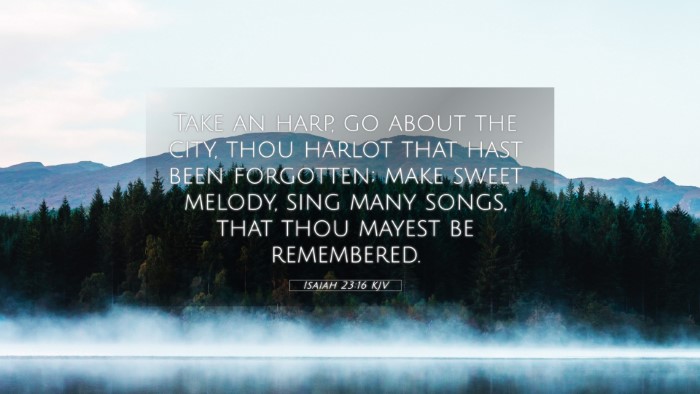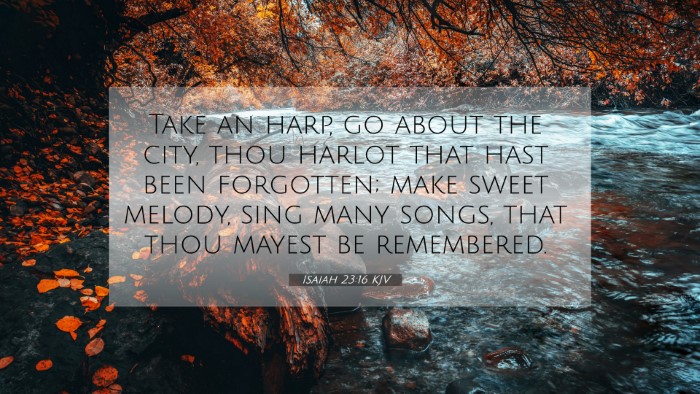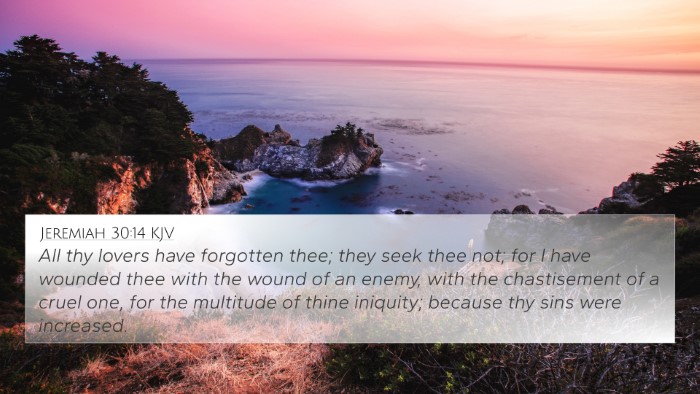Understanding Isaiah 23:16
Isaiah 23:16 is a profound verse that invites contemplation on the themes of judgment and restoration within the context of the fall of Tyre. This verse states:
"Take a harp; go about the city, thou harlot that hast been forgotten; make sweet melody, sing many songs, that thou mayest be remembered." (Isaiah 23:16, KJV)
Summary of Isaiah 23:16 Meaning
This verse metaphorically illustrates the call for Tyre, described as a “harlot” for its unfaithfulness to God, to engage in music and song as a means to regain its memory and presence in the minds of others. Public domain commentaries offer various insights:
-
Matthew Henry:
Henry emphasizes that this verse serves as a reminder of the sinfulness and eventual downfall of Tyre due to its pride and unfaithfulness. The “harp” symbolizes joy, but it's presented in a context of sorrow for what has been lost.
-
Albert Barnes:
Barnes notes that the call to make music implies an ironic twist; the city that once thrived will now attempt to revive its glory through art and song, yet it will ultimately be an acknowledgment of its desolation.
-
Adam Clarke:
Clarke provides insight into the significance of the “forgotten harlot.” He highlights the dual notion of beauty and ruin, suggesting that despite its past allure, Tyre's future is marked by lamentation rather than celebration.
Deep Dive into Context and Imagery
The verse captures a vivid picture of the aftermath of destruction, where the remnants of Tyre are instructed to play music as a form of poetic, yet tragic expression of their lost glory. The underlying themes are:
- Judgment: Tyre’s fall is a result of divine judgment against its hubris and idolatry.
- Restoration: The act of making music hints at a longing for restoration, albeit in an ironic context.
- Memory and Legacy: Music serves as a medium for memory, urging a forgotten people to remember their former glory, yet also leading to reflections on their disgrace.
Cross-References Related to Isaiah 23:16
Isaiah 23:16 has several relevant cross-references that deepen its understanding. Below are selected verses that connect with Isaiah 23:16:
- Isaiah 10:12: Discussing the judgment of nations, similar to the fate of Tyre.
- Isaiah 14:31: A pronouncement of woe, casting a shadow over places of former prosperity.
- Isaiah 15:8-9: Lamentation and mourning over desolation echoing despair similar to Tyre's situation.
- Ezekiel 26:16-17: The fall of Tyre foretold and the reaction of other cities, symbolizing connected fates.
- Revelation 18:22-23: A warning against the pride of Babylon, which serves as a thematic parallel to Tyre's downfall.
- Jeremiah 25:22: Another city falling under divine judgment, emphasizing the fate shared by Tyre.
- Amos 1:9: Condemnation of Tyre for transgressions against Israel, establishing historical links.
- Matthew 11:21: A New Testament reflection on cities of sin and their judgment.
- Luke 10:13: Similar commentary regarding unrepentant cities, illustrating patterns of divine retribution.
- Isaiah 24:7-12: The desolation of the earth and its cities, pointing to the universal consequences of sin.
Thematic Connections and Analytical Insights
The themes of Isaiah 23:16 can be understood through various lenses of inter-Biblical dialogue:
- Judgment and Accountability: The sorrow of Tyre reflects broader biblical principles of accountability, seen in numerous scriptures across both Testaments.
- Restoration and Hope: Despite the harrowing circumstances, the remnant's call to sing indicates a potential for renewal, resonating with themes found in the Psalms (e.g., Psalm 137).
- Historical Reflection: The historical context of Tyre as a significant trading city underlines the transient nature of earthly glory.
Practical Application for Study
When engaging with Isaiah 23:16, consider the following study methods using tools for Bible cross-referencing:
- Observation: Note the imagery of music in contexts of judgment and restoration.
- Comparison: Analyze the nuanced meanings of judgment across different books of prophecy.
- Reflection: Contemplate personal implications of pride and repentance as exemplified by Tyre.
- Application: Relate Isaiah’s warnings to contemporary society’s idols and potential falls.
Conclusion
Isaiah 23:16 serves as a poignant reminder of the results of unfaithfulness and spiritual desolation. The verse, along with its associated cross-references, invites the reader to reflect on the deeper themes of judgment and potential redemption found in the Scriptures. By exploring these connections fully, one gains a richer understanding of God’s message throughout the Bible.




